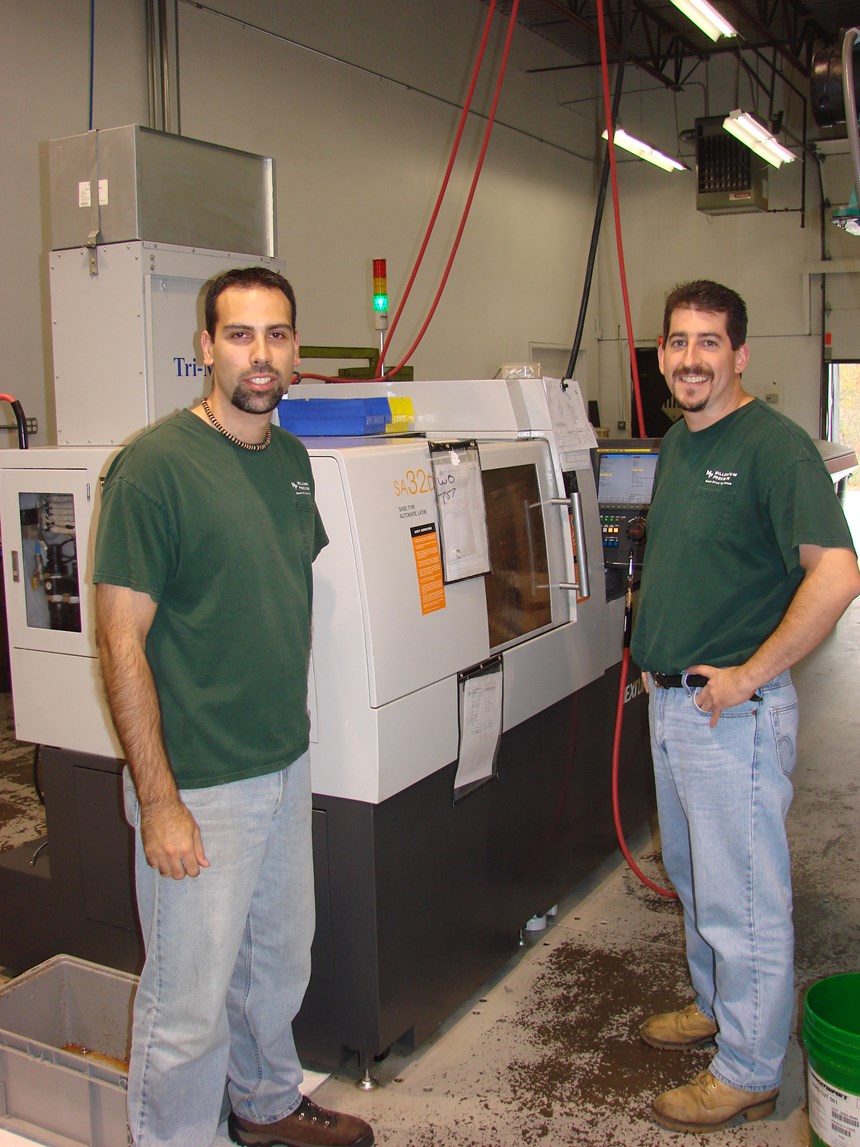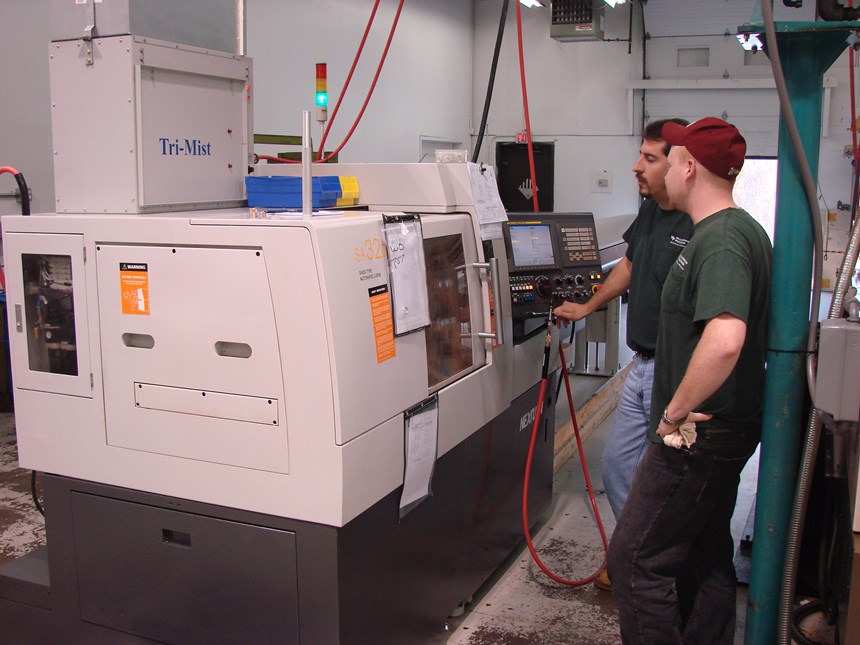Drafting New Players For Swiss Precision
Consistent operations play a big part in attaining high productivity. That’s why, as a shop grows (as this Swiss shop has), it should look to add machines—and employees—that complement each other.
The atmosphere of northern New England in the fall is always exciting. The approach of cooler weather gets the blood flowing, and of course, the transition of the leaves, with their vibrant colors, has always been a draw for visitors to the region. This year, area baseball and football teams are adding significantly to this excitement as the Boston Red Sox have won the World Series, Boston College is in contention for a national title, and the New England Patriots are a dominant force in the NFL. Emotions are high and the enthusiasm is contagious.
At a small, but quickly growing New Hampshire job shop specializing in Swiss-style machining, the same energy can be sensed as employees team together to make their company a winner as well. Millennium Precision, LLC (Londonderry, New Hampshire) has brought together a group of individuals, a lineup of equipment and a strategy for growth that will allow them to celebrate well beyond any post-season.
Featured Content
Opening Day
In June 2003, Sean Duclos purchased a used (1994) Citizen L3-20 Type VII multi-axis Swiss lathe andbegan the business in a small garage. He was coming off of 13 years of previous experience in a Swiss house, managing a team of about 22 people on 25 machines, so he had a good idea of where he would like to take his company.
After the first year, Sean added his first employee, General Manager Eric Filiatrault, and a second machine, a Citizen M1-20. Having worked together for 7 years in a previous job, Sean and Eric felt they complemented each other well and would be able to build a solid team to carry the shop through the next level.
As they built the business, Sean and Eric made a point to hire other employees with similar attitudes— people who take the business seriously, feel they have a personal stake in the work and see their co-workers as friends. To attract that kind of individual, they developed and maintain a relaxed environment where workers are free to contribute creative ideas for better performance and are rewarded with better than average salaries and benefits. Even on this autumn day, Eric was preparing a steak dinner on the grill, timed for the shift change so both first and second could enjoy.
The business has now grown to having two manned shifts, with an average of 50 percent of the machines running untended during the third shift. Beyond Sean and Eric, six full-time employees and one part-time employee are on the shop floor. Roughly once each year since the start, Sean has added one new machine to the lineup. Until the most recent addition, this lineup has consisted solely of Citizen lathes, including an L5-20 and an additional M1-20.
Change In The Lineup
In the second quarter of 2007, Sean and Eric set out to increase production capacity by acquiring the company’s first 32-mm machine. So far, each machine on the floor was purchased used, but Millennium was now in a position to address a specific need with precisely the right piece of equipment. Because of a long association with Ben Brown, representative for Tyler Machine Tool Company (Seabrook, New Hampshire), they agreed to take a look at the NexTurn line of CNC Swiss machines. NexTurn, distributed in the U.S. by Tyler, began building six-spindle machines in 1986 and advanced into CNC Swiss-types in 1999.
Sean and Eric chose the NexTurn SA32D, which features a one-piece casting bed for high rigidity. It has full seven-axis simultaneous capability, nine driven tools (with a total of as many as 21 tools), and a full C axis (0.001 degrees) with built-in direct drive motors on both the main and subspindle. Both spindles are cooled with an oil cooler to maintain thermal stabilization throughout the production cycle. Sean explains, “The NexTurn gave us 32-mm capacity that we didn’t have before, along with a little more flexibility with the layout regarding some live tooling capability. Front-position and backwork live tooling were standard. It was particularly enticing, though, because the format of the machine is similar to that of the Citizen machines that we already have on the floor.”
Sean is a firm believer in consistency—finding something that works and repeating it. By bringing in the NexTurn machine, he was able to add the capabilities the company needed while making the transition to a new machine relatively smooth. “The 32-mm NexTurn is very similar to the L-5 Series Citizen,” he explains. “It is a proven format that is familiar to us and has worked well. Thermally, it’s very consistent. We liked that we could get that same format in a larger machine.”
One area in which, up until now, Sean has struggled with keeping things consistent has been the company’s bar feeders. “In buying used equipment, one of the downsides was that we had little choice, getting the bar feeder that was already matched with the machine,” he says. “As a result, we now have bar feeders from three different manufacturers. Because of the performance of the LNS bar feeder we already had, we decided to purchase another one with the NexTurn and stay with LNS going forward.”
Sean feels the NexTurn machine has filled the void effectively and fit into the shop seamlessly. “It provides the level of performance we’ve come to expect
from our equipment, holding tolerances in the areas of a tenth, similar to our other machines. Cycle times are down because the machine’s rapid rates are right there with the other equipment. We’re even able to get high-pressure coolant on the machine, and we use the same air filtration unit.”
Clutch Performance
Consistency has paid off for Millennium in its hiring and training processes as well. Sean says the company’s biggest challenge has been finding quality people who are knowledgeable of today’s industry trends and have Swiss experience. As a solution, he offers, “We try to minimize the challenge by making the work environment very enticing to the quality people who are out there. We also are putting training procedures into place as well to make sure
they are prepared to do the job. This training includes visits to the machine tool distributors’ facilities as well as on-the-job programs.
Tyler Machine Tool Company has been supportive in these training efforts. With the installation of the new machine, training has been readily available. “The primary NexTurn guy and one other person each spent a week at our facility,” Sean says. “A lot of training took place at that time. Ben is always available as well, and he checks in from time to time to see how things are going. The service department has been very responsive for the few minor issues we’ve experienced, and we had lots of help in the early stages of learning the programming of the machine.”
A solid combination of equipment and personnel has brought the company to a period of steady growth. The company has developed a strong customer base throughout New England and into the Midwest. Running quantities typically between 5,000 and 50,000 parts in aluminum, brass, stainless and regular steels and titanium, about 40 percent of the work that Millennium performs is in medical, with the rest in aerospace and private industry. The medical work is primarily focused on instrumentation and tooling such as bone taps and bone drills, but one job of particular interest is a prototype for an implant to help the human heart. “It’s not the heart itself, but it goes around the heart to help reshape it to stop leaky heart valves,” Sean reveals. “The part is made completely out of titanium. It allows the doctor to hook wires around the heart and tighten them to reshape the heart. With about 15 million people diagnosed each year with a leaky heart valve, we foresee this being a big runner for us.”
As for long-term plans, Sean forecasts, “We will continue to add equipment as we need it, and we will base our decision on what we need at that point in
time and who has the better format for those needs.” The company has grown in revenues from 35 to 50 percent each year, so the need for more equipment is inevitable. “We would like to add more capability in our 32-mm range. The NexTurn machine has definitely impacted our sales; obviously, the added capacity has helped. But the other thing is that it has opened doors to current customers that were closed before because of the size constraints that we had. We’re becoming more of a one-stop shop for our customers.
“Moving forward, we would like to get into laser marking, which we see on a regular basis with the types of work we do. We would also consider adding some more complex and intricate types of secondary operations that we are currently sending out. We would like to build more partnerships with our outside vendors.”
Sean’s goals for the company are big, but he sees no reason not to follow suit with the other successful enterprises in the New England area at this time. He would like to build what he refers to as Millennium Manufacturing Complex, teaming with his contacts in the industry to provide a single location—a manufacturing area—to reduce the movement of parts and complexity of the production process. This is exactly the type of creativity and enthusiasm that drives any winning team.
RELATED CONTENT
-
Checklist for Lights-Out Manufacturing
Many shops of various sizes are trying to hop on the lights-out bandwagon. This article looks at some things to consider and check out before “hopping.”
-
Advantages of Cellular Manufacturing
Manufacturing cells are used to minimize product movement as well as materials, equipment and labor during the manufacturing process. By reducing cycle times and material handling, these cells help shops more easily meet customer demands regarding cost, quality and leadtimes.
-
Making Waves with Lathe Automation
After years of relying on an extensive machining cell for part production, this marine equipment manufacturer has now reduced part handling and improved quality through use of single-setup lathes and automated loading and unloading.












